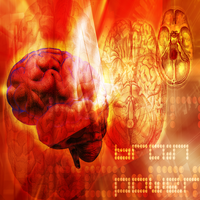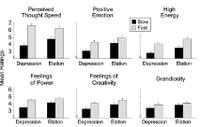Overcoming Rejection

I am sure that most of us have faced some form of rejection at some time or other in our lives. People with high self-esteem seem better able to take rejection in their stride, but usually only if it is “earned.” Simply trying artificially to build your self-esteem rather than having built it on a platform of past achievement, will probably not work very well.
New research in the journal Psychological Science from UC Berkeley indicates that this does not mean that people with low self-esteem are doomed to respond defensively to criticism and rejection. The key seems to be that people who are better at controlling their impulses are less vulnerable to rejection.
There were 38 female and 29 male participants in the study. The first completed the Rosenberg self-esteem scale, one of the most widely used self-esteem measure in the social sciences. They then completed a questionnaire on their ability to focus on tasks at hand without distraction. The subjects were arranged into two groups – low self-esteem and normal-to-high self-esteem – based on their scores on the Rosenberg scale.
Each of the volunteers then viewed images showing positive, neutral, negative and rejection themes while being subjected to sporadic loud noises. A startle probe measured the force of their eye-blinks in response to the abrupt sounds. Eye blinks are a good measure of the startle response and correlate fairly well with the activation of the “fight or flight” reaction.
As anticipated, all the participants blinked more strongly when the loud noise was paired to such negative images as dead animals or mutilated bodies. However, the people with low self-esteem blinked more forcefully in response to pictures portraying themes of rejection loneliness and alienation. Paintings with negative themes or acceptance themes, such as lovers embracing, did not elicit the same response in low self-esteem people.
In other words the powerful was in which rejection activates the threat system in people with low self-esteem suggests that their fear of rejection runs extremely deep and engages neurological systems involved in reacting to a threat.
On the other hand, those with low self-esteem who scored higher for attention control, which included the ability to focus, were able to modulate their immediate reactions to rejection.
Some previous work has suggested that self-esteem is part of a primitive emotional warning system that warns us if we are in danger of being socially excluded. While the evolutionary function of this detection system was originally intended to motivate people to stay socially connected, the constant anticipation of rejection can create problems, with the system being triggered by the merest whiff of rejection. They may become hypersensitive and have a brain that generates a cascade of defensive reactions if they sense any kind of disapproval.
Although this is a small study, the evidence is that rather than teaching self-esteem skills, the solution for them might be to improve their abilities to focus, concentrate and regulate their internal states.
In other words develop some specific forms of self-control and resilience.
For many people this may be the most effective way of helping them to cope with disappointment and maintain close relationships.
“No man is free who is not master of himself.”
–Epictetus (Phrygian-born Greek Stoic Philosopher, c.A.D.55- c.A.D.135
“It is not the mountain we conquer but ourselves.”
–Sir Edmund Hillary (New Zealand Mountaineer and Explorer, 1919-
“Mind control is not one’s birthright. The successful few owe their success to their perseverance.”
–Ramana Maharshi (Indian Hindu Mystic and Spiritual Teacher, 1879-1950
“The cyclone derives its powers from a calm center. So does a person.”
–Norman Vincent Peale (American Cleric, Writer and Self-Help Expert, 1898-1993)
Meditation, Stress and Self-Regulation

There is progressively more evidence that meditation can have measurable effects on behavior and the brain. The trouble is that some of the results have conflicted, mainly because of the different types of meditation and different measurement protocols. So I was very interested to see some new research in this week’s issue of the Proceedings of the National Academy of Sciences, by a team of researchers from China collaborating with renowned experts at the University of Oregon, who have developed an approach for neuroscientists to study how very brief meditation training might improve a person’s attention and response to stress.
The study itself was done with undergraduate students in China. The experimental group received five days of meditation training using a technique called integrative body-mind training (IBMT), which was developed in China n the early 1990s.
IBMT is a rapid mental training method that aims at inducing a state of alert restfulness using breathing and guided imagery.
The control group received five days of relaxation training. Before and after training both groups took tests involving attention and reaction to mental stress.
The experimental group showed greater improvement a test of attention that was designed to measure peoples’ ability to resolve conflict among stimuli. Subjects were stressed by doing mental arithmetic.
At the beginning of the experiment both groups showed an elevated release of cortisol following the mathematical task, but after training the experimental group showed less cortisol release. This probably indicates an improvement in stress regulation. The experimental group also showed lower levels of anxiety, depression, anger and fatigue than the control group.
The next stage in the research will involve direct measurements of brain function.
Although IBMT is described as a form of meditation, it may be inducing something slightly different from, say, Zen meditation. The important point is that it is possible to produce measurable physiological changes in just five days, and this will make it much easier to examine the dynamic effects of hypnosis, relaxation and this technique on brain function.
I would also be grateful for any readers who have more information abut the precise details of IBMT, and whether training in the precise techniques is available outside China.
I shall keep you posted as new data emerge.
“Peace can be reached through meditation on the knowledge which dreams can give. Peace can also be reached through concentration upon that which is dearest to the heart.”
–Patanjali (Indian Philosopher said to be the Compiler of the Yoga Sutras, Dates Unknown)
“Through meditation and by giving full attention to one thing at a time, we can learn to direct attention where we choose.”
–Eknath Easwaran (Indian-American Spiritual Teacher, Professor and Author, 1910-1999)
“Meditation is not to escape from society, but to come
back to ourselves and see what is going on. Once there is
seeing, there must be acting. With mindfulness, we know
what to do and what not to do to help.”
–Thich Nhat Hahn (Vietnamese Buddhist Monk, 1926-)
“A meditator keeps his mind open every second. He is constantly investigating life, investigating his own experience, viewing existence in a detached and inquisitive way. Thus, he is constantly open to truth in any form, from any source, an at any time.”
–Henepola Gunaratana (a.k.a. Bhante G., Sri Lankan Buddhist Monk, 1927-)
Who’s In Charge of Your Brain?

There has been a lot of discussion in the neuroscience community about the way in which different circuits in the brain are integrated. We know that the right and left sides of the brain normally operate together, and that most of the time the three major systems of the brain: reptilian, limbic and neocortical regions work together. However, we have also speculated that one of the causes for some neurological, psychological and psychiatric illnesses might be a result of “disconnections” between different regions of the brain. The idea that some brain regions may be uncoordinated goes back more than a hundred years, but was resurrected and developed quite brilliantly in the 1960s by one of my mentors, the late Norman Geschwind, who was one of the three smartest people that I ever met.
Now there is some new research that may have important implications for neurology and psychology.
Colleagues from Washington University School of Medicine in St. Louis have found strong evidence that there is not one but two complementary commanders in charge of the brain. It is rather like having two captains in charge of the same ship.
The two captains are networks of brain regions that do not consult each other but still work toward a common purpose: the control of voluntary, goal-oriented behavior. These behaviors include a vast range of activities from walking and talking, reading and deciding on a course of action. There are yet other systems that control behaviors that are usually involuntary such as control of the pulse rate or digestion.
Last year the researchers found that there are 39 brain regions that consistently became active before the brain goes to work on a task. They did this through functional magnetic resonance imaging (fMRI) scans that follow the oxygenation of the blood. As a region of the brain is activated, blood flow increases and we can work out which brain regions are contributing to a mental task. One of the keys to our mental capacity is the ability to recruit different parts of the brain as we need them. The previous research suggested that these brain regions create task sets: plans for using the specialized talents of various brain regions to achieve a goal. Let me give you an example.
Read the word: CAT
You can do many things with that word: make a mental image of a cat, read it aloud, make rhymes or lists of words and so on. And each of those activities involves a different set of circuits in the brain. The person with good powers of attention and concentration is able to mobilize and coordinate more of his or her mental resources than the person who is less focused on a task.
In this new study the researchers used a different brain scanning technique called “resting state functional connectivity MRI.” Volunteers were asked to relax while their brains are scanned instead of working on a task.
They then used graph theory, a branch of mathematics that visually graphs relationships between pairs of objects to work out how different brain regions are coordinated. This mathematical technique is rather like the party game Six Degrees of Kevin Bacon, in which you use paired connections to go from one actor or actress to another until you’ve identified a chain of connections linking Kevin Bacon and another actor, actress or movie that wasn’t immediately obvious.
They were able to identify pairs of brain regions where blood oxygen levels rose and fell roughly in synch with each other, implying that the regions most likely work together. What they found was two separate systems. Each system had multiple connections to other regions in its own team, but they never connected to regions on the opposite team.
Having established the existence of two control networks, the next task was to work out their roles. One network – the “cinguloopercular network” – was linked to a “sustain” signal. It turns on when you start doing a task and stays constant while you do it. When you are finished it switches off.
The second is the frontoparietal network that is consistently active at the start of mental tasks and during the correction of errors.
In some senses this is not too much of a surprise. Many systems of the body have multiple control systems. I have often talked about the scores of systems involved in the control of body weight, which means that a dietetic approach directed at only one system is doomed to failure. If the body thinks that it is starving other systems jump in to slow your metabolism, reduce your activity level and make you crave certain foods.
Another good example is body temperature. Your temperature is regulated by several independent factors including your sweat glands, metabolism and activity level. If one of them goes wrong, other systems will try and compensate. When one controlling factor goes awry, others can try to compensate. The controls of your weight and body temperature are known as complex adaptive systems, and they are found not only in biology, but also in ecology, economics and atmospheric dynamics. We study them using an approach called network dynamics.
The findings may help our efforts to understand the effects of brain injury and develop new strategies to treat such injuries.
They may also help us understand problems like goal-directed behavior and human motivation.
If only one of the two systems has agreed that you need to go out and exercise, it may help us design new strategies to help you and explain why some approaches to, say, diet and exercise, are more effective than others.
Groundbreaking stuff!
Biofeedback for Tension Headaches

Tension headaches are common and can cause a great deal of pain and distress. They can also be hellish hard to treat.
Medicines do not always help, so I have since the 1970s been interested in anything else that could help. In 1982 my boss gave me the money to set up a biofeedback laboratory at Charing Cross Hospital in London, and it turned out that this form of treatment helped around a third of people with tension headaches. Most experts have assumed that biofeedback helps by reducing muscle tension, though I have never been so sure: not everyone with tension headache has increased muscle tone, and many simply reported that they felt less stressed and more in control of their lives.
So it was very interesting to see some new research (NR10) presented yesterday at the 2007 Annual Meeting of the American Psychiatric Association in San Diego, California.
Researchers from Ingok Ja-Ae Hospital in Chungbuk Eumseong, South Korea looked at the efficacy of biofeedback assisted autogenic training for chronic tension headaches.
They examined 35 people aged 20-40 with chronic tension headaches. 17 had treatment as usual, and 18 received 8 sessions of biofeedback. The researchers used some standard measures of headache. Both groups improved, but the people who had biofeedback showed a greater improvement using a simple visual analog scale.
But this is what was interesting: people who had biofeedback had a significant improvement in their levels of anxiety and depression. The reductions of anxiety correlated with the improvements in headache, while biofeedback had no impact on the electrical activity of the muscles in the head and neck. This is an important finding, since it suggests that biofeedback may be helpful with other problems in which anxiety is an issue. There are few problems that are only physical or only psychological: there will almost always be a psychological component in anyone who suffers from chronic pain.
I recently discussed the use of a particular form of biofeedback that seems to help many people with attention-deficit/hyperactivity disorder (ADHD). The treatment seems to help attention itself, but it would also be very helpful if it reduces anxiety, since excessive worrying is a common issue in ADHD.
I shall keep you updated on the use of biofeedback as more research is published.
The most important conclusion from all this work is that it confirms that the mind has extraordinary powers over the body.
And that is incredibly encouraging for all of us.
Non-pharmacological and Lifestyle Approaches to Attention-Deficit/Hyperactivity Disorder: 6. Biofeedback

It seems odd that hyperkinetic children and adults with attentional problems should be able to stop long enough to try yoga, meditation of biofeedback. Yet there is good evidence that they can and they do, and that all three modalities can be helpful.
Today we are going to look at the use of a specific form of biofeedback.
Neurofeedback is a form of behavioral training that is aimed at developing skills to help people self-regulate the activity of their brains.

The first attempts to use biofeedback in children with behavioral problems took place in the early 1980s, following some interesting work on using it to control epilepsy, headaches and an array of other problems. Several good quality neurofeedback studies have been published over the last ten years.
In neurofeedback training, people are taught to control specific aspects of electrical brain activity. They are hooked up to machine that records electric impulses from the brain – a form of electroencephalograph (EEG) and they are given immediate feedback and positive reinforcement, usually using a visual display.
In frequency training, people are asked to increase or decrease the activity of different EEG frequency bands. To learn to regulate their level of cortical excitability they are trained to generate and regulate slow cortical potentials (SCPs). Slow cortical potentials are slow event-related direct-current shifts of the EEG.
With a little practice, almost anyone can learn the basic techniques, and as they do, they constantly improve their ability to regulate their attention, thoughts, moods and reactions. Many young people with attention-deficit hyperactivity disorder (ADHD) look at it like a game, and quickly become engaged with it.
Studies of neurofeedback have shown some specific effects on attention and memory processes. The key point is that the improvements in performance are maintained once the person is engaged in real-life activities. The techniques can be used to help healthy people perform better as well as helping people with problems.
Several studies have shown that children with ADHD had improvements in behavioral and cognitive variables after both frequency (e.g., theta/beta) training and SCP training. Some of the improvements have been sustained for six months. It has also been possible to show improvements in some neurophysiological measurements. Most studies have been done in children with ADHD, and in most other things were done as well. For instance the children were kept on medications, or children were given other types of exercises to reinforce what they were learning.
There has been some good brain imaging research that has shown that neurofeedback in children with ADHD normalizes the functioning of the anterior cingulate cortex, the key neural substrate of selective attention
There is also another type of feedback training. There is evidence that the level of activity in a classroom containing hyperactive boys can be reduced using feedback about the level of activity together with positive reinforcement. Some recent research has produced preliminary data in which investigators used a device that combines a beeper and actigraphy technology for measuring, monitoring, and modifying motor excess in children. The feedback reduced the activity level of seven out of nine hyperactive boys.
There remain a lot of unanswered questions about biofeedback in the treatment of ADHD. In an excellent review article, John Gruzelier and Tobias Egner from London pointed out that neurofeedback had grown and been widely adopted with little in the way of research to back it up. However their own work has shown that the technique can help improve cognition, and they provided the first evidence of conscious control over the ratio of alpha and theta waves in the brain. They also showed that the technique could lead to remarkable improvements in artistic aspects of music performance, which were equivalent to two class grades in conservatory students.
The evidence for biofeedback is growing, and since it is non-invasive ad may be associated with a number of other improvements in mood and cognition, it will likely bean important option for some people with ADHD.
Marijuana and Psychosis

A number of my friends and colleagues in London have shown how cannabis (marijuana) may trigger a psychotic illness. A team at the Institute of Psychiatry gave healthy volunteers the active ingredient tetrahydrocannabinol (THC).
They then recorded reduced activity in an area of the brain called the inferior frontal cortex that keeps inappropriate thoughts and behaviors in check. The inferior frontal cortex is part of the self-regulatory systems of the brain that stop us swearing inappropriately, and help us to realize that people are not looking at or spying on us. In other words the inferior frontal cortex checks the environment and stops us jumping to conclusions that could lead to paranoia.
The THC was given to healthy volunteers who had not abused marijuana. The effects were short-lived, but more sever in some people than others, suggesting a genetic vulnerability.
In another study from Yale University, THC was given intravenously. Even at fairly low doses, 50% of healthy volunteers began to show symptoms of psychosis. As expected, people who had a previous history of psychosis were particularly vulnerable to the effects of THC.
A separate study has shown that one of these ingredients – cannabidiol (CBD) – has the potential to dampen down psychotic symptoms, and could perhaps form the basis of new treatments.
Whenever people start talking about the possible association between psychiatric problems and using marijuana, there are always loads of people who protest, “But I’ve used it for years and it’s never done me any harm.”
They may be right, but that objection misses four important points:
- People vary in their sensitivity to marijuana. Mental illness is the result of both genes and environment. Somebody who is very stressed but has no known genetic predisposition may run into trouble, while somebody with strong genetic loading and a minimal amount of stress can get very ill very quickly. And that stress can be anything from marijuana to abuse. There is also a lot of variation in how people respond to specific types of stressors
- If people have already had some psychological trouble, marijuana can be like pouring gasoline on a fire
- The age at which marijuana is used is all important. There seem to be “critical periods” in brain development, when marijuana can be particularly risky. There is a strong correlation between the number of times someone uses it under the age of eighteen and their subsequent risk of developing psychosis later in life. This relationship does not seem to hold with regular cigarettes, alcohol or any of the other street drugs looked at so far, suggesting that this is not just a matter of young people who are self-medicating. We cannot prove “causality” any more than we can “prove” that cigarette smoking causes lung cancer. Trying to prove a single cause for an illness is a tricky business. There are some examples, for instance illnesses caused by a single gene, but they are few and far between
- The marijuana available today is very different from the anemic material that was available in the 1960s and 1970s. Today’s is far powerful
This research provides the strongest evidence yet that modern marijuana can have a significant impact on the brain. Proving a long-term effect would be extremely difficult: it would be neither ethical nor feasible to stimulate long-term psychosis in volunteers.
But clearly if something has an active effect in inducing the symptoms of psychosis after one dose, it would not be at all surprising if repeated use could induce a chronic problem, particularly if someone is genetically predisposed.
Temptation

Have you ever given in to temptation? Have you ever had a moment of weakness when that jelly donut seemed just too irresistible or you felt that it was about time to tell someone what you REALLY thought?
Sad to say I am sure that we are all guilty of that at some time or other.
What we are talking about here is self-regulation, our ability to inhibit impulses, make decisions, persist at difficult tasks and to control our emotions. We know that our ability to self-regulate is highly variable. It becomes more difficult if we are tired, stressed or working with people who drain us emotionally. There is evidence that our abilities to self-regulate can fatigue in just the same way that a muscle can get tired. It’s like having a limited amount of money, and when it’s gone it’s gone. One of the main factors that help to keep self-regulating is our level of resilience.
It is interesting that when we give in to the temptation to do something unwise, we are often unaware of it at that moment. It is only later that we feel regret.
There is some interesting new research from the University of Kentucky, that was conducted by two psychologists Suzanne Segerstrom and Lise Solberg Nes. Their work suggests that there may be a biological indicator to tell us when we are working hard at resisting temptation and consequently when we are vulnerable to doing things that we hadn’t meant to.
They hypothesized that there would be a link between variations in heart rate – heart rate variability (HRV) – and self-regulation. HRV is emerging as a very interesting tool for examining the health of the autonomic nervous system, and if disturbed, it can be a harbinger of many highly undesirable health problems. The researchers’ reasoning was that many of the same brain structures involved in self-regulation are also involved in the control of HRV.
They did a two-part study to test their hypothesis. In the first experiment participants were told that they were going to take part in test on the “physiology of food preference.” They were instructed to fast for three hours before starting the procedure. Then their HRV was monitored while they were presented with a tray of cookies, candy and carrots. The “temptation” was to give in to eating the tastier but the less healthy snack of cookies and candy.
HRV was considerably higher when people were working to resist temptation (eating carrots rather than cookies and chocolate) than when they were not. This suggested that HRV was mirroring the attempt at self-regulation.
In part two of the experiment, after resisting or giving into temptation, the experimenters had the participants attempt to complete difficult anagrams, some of which were impossible to solve. The authors measured how long participants persevered at the anagrams. As predicted, those who had exerted high self-regulation by resisting the candy and cookies were more likely to give up earlier on the task. They didn’t have any more self-control to give.
People with naturally higher levels of HRV were likely to try longer at the anagram task, whether or not they had given into “temptation.”
Now the “temptation” in this study wasn’t much, but the implications are important. There are many people – particularly those with addictions and some kinds of personality disorder – who have major problems with self-regulation. HRV feedback could turn out to be a useful way of helping people realize that their self-control may be about to fail.
It is also important to know that self-regulation is finite, but can be built by building an individual’s resilience (1,2,3,4,5).
By the way, if you have never given in to temptation, would you PLEASE share your secret?
“Watch and pray, that ye enter not into temptation: the spirit indeed is willing, but the flesh is weak.”
–The Bible: Matthew 26:41
“A silly idea is current that good people do not know what temptation means. This is an obvious lie. Only those who try to resist temptation know how strong it is…. A man who gives in to temptation after five minutes simply does not know what it would have been like an hour later. That is why bad people, in one sense, know very little about badness. They have lived a sheltered life by always giving in.”
–C. S. Lewis (British Scholar and Novelist, 1898-1963)
“What makes resisting temptation difficult for many people is they don’t want to discourage it completely.”
–Franklin P. Jones (American Businessman, 1887-1929)
“Temptation is an irresistible force at work on a moveable body.”
Henry Louis (H.L.) Mencken (American Writer and Editor, 1880-1956)
Thinking Speed, Mood and Optimism

There’s a very interesting article at the Mixing Memory blog. It’s one of the blogs that I highlight in the “What I’m reading” section. The articles highlights some recent research by Emily Pronin and Dan Wegner from Princeton and Harvard respectively, entitled “Manic Thinking: Independent Effects of Thought Speed and Thought Content on Mood.”
It’s about an intriguing issue. People who have a manic illness have an acceleration of thinking processes together with elevated mood and energy level. Mania is also associated with racing thoughts grandiose or creative ideas, fast, uninterruptible speech, aimless pacing, irritability and an over-involvement in pleasurable activities, together with a loss of impulse control.
It may sound great, and initially people are often very happy to be manic. But after a while it can give way to exhaustion or the realization that some of their choices have been unwise. I once knew someone who was driving a brand new BMW – that she could definitely not afford – at over 120 miles an hour, the wrong way down Interstate 95. That’s when the police became involved, and they immediately realized that she was not a villain, but a very sick person who could have killed herself and a ton of other people.
The researchers they had a group of college undergraduates read a series of 58 emotion-inducing statements out loud, and to do it at either a fast or slow pace. The statements are emotionally neutral at the beginning and then become progressively more emotionally positive or negative. The idea is that reading a series of progressively more positive or negative statements will affect the reader’s mood. The letters in the statements were presented one at a time, either for 40 milliseconds per letter (“fast thinking” condition) or 170 milliseconds per letter (“slow thinking”). A pilot study indicated that the 40 milliseconds per letter reading time were about twice the normal reading speed for college undergraduates and 170 milliseconds were about half the normal speed. The time between statements also varied, with only 320 milliseconds between statements in the “fast condition” and 4 seconds between statements in the “slow condition.”
After reading all 58 statements, the participants were asked to answer a series of questions designed to assess their mood, energy level, feelings of power, creativity and inspiration. There were also questions to evaluate “grandiosity or inflated self-esteem,” together with their own perceptions of their speed of thought.
Subjects in the “fast thought” condition reported faster thought speeds than those in the “slower” condition. As predicted, faster thought speeds affected mood and mania-related feelings, participants in the fast thought condition reported being happier, had higher energy levels, experienced greater senses of power and creativity, and higher levels of grandiosity (though self-esteem did not differ between conditions). What is important, is that these effects were independent of the mood manipulation (positive or negative statements). Here is a graph from the paper presenting the effects of slow and fast thinking as a function of the type of sentence:

This study has some important implications. Thinking more quickly produces elevations of mood and self-perception that can smetimes be similar to those of very mild mania. I have seen this happen frequently when people have been up all night: the bright lights of morning and a few cups of coffee make them appear mildly manic. For a time they do in fact impress with their creativity and mastery not only of details, but of the “Big picture.” But as time goes on, much of their thinking turns out to be not altogether logical.
The study also raises the possibility that some manic symptoms may be produced by thinking. There is an old term from the psychoanalytic literature called “manic defense,” in which people use manic-like symptoms to protect themselves – or more accurately their ego structures – when under stress.
I have spent most of my life with people who think very quickly and accurately. Most also express themselves very well: both succinctly and fluently. But all have also known the importance of stopping for a while after a brainstorming session, so that we can see if our ideas have really born fruit, or if they just seemed a good idea at the time.
There is no question that moving and speaking more quickly can elevate our mood. It is no surprise that it has little impact on self-esteem. It is becoming more and more clear that self-esteem follows from genuine achievement. Boosting artificially is difficult, with one exception: when people have every reason to have decent self-esteem, but instead they keep feeling bad, as if they have a kind of leaky bucket as my friend the psychiatrist Stephen Preas calls it.
I remember an experiment in which an investigator was experimenting with ether. During one of his sessions he had a deeply felt mystical experience in which he was sure that he suddenly understood the whole of nature and reality. He immediately wrote it down so that he could show the world The Secret.
When he came back down to earth, he looked at what he had written, “The world is like a fish…”
“The world that we have created is a product of our thinking. It cannot be changed without changing our thinking.”
–Albert Einstein (German-born American Physicist and, in 1921, Winner of the Nobel Prize in Physics, 1879-1955
)
“Some would sooner die than think. In fact, they often do.”
–Bertrand Russell (Welsh Mathematician, Philosopher, Pacifist and, in 1950, Winner of the Nobel Prize in Literature, 1872-1970)
“Most people can’t think, most of the remainder won’t think, the small fraction who do think mostly can’t do it very well. The extremely tiny fraction who think regularly, accurately, creatively, and without self-delusion. In the long run, these are the only people who count.”
–Robert Heinlein (American Writer, 1907-1988)
Rethinking Cancer
Over the last thirty years, there has been a gradual change in the way in which we conceptualize biological processes. Although the lion’s share of research is still dedicated to biochemical processes involving DNA, RNA and the cell membrane, other important concepts are being quite widely accepted. They include:
- Fetal imprinting
- Epigenetic control
- Self-organization
- Self-regulation
- Coherence over time
- Information exchange with the environment
- Symbiosis
- Morphogenesis
One way of thinking about this is to describe cells, organs and bodies as coherent information-rich processes. And when things go wrong, it is because these processes have gone awry. Information medicine is designed to bring the system back into coherence and harmony.
I have spoken before Integrated Medicine and in the next posting I am going to talk more about the difference between Integrated, integrative and integral medicine. But at this point suffice to say that Integrated Medicine is information medicine based on an understanding of these principles.
Several years ago I presented a paper at a closed meeting where I introduced the term “adult dysmorphogenesis,” to describe the way in which some disease processes – such as arteriosclerosis, arthritis and Alzheimer’s disease – could be better understood not as degenerative conditions, but as deranged information systems. These in turn disrupted the normal self-organizing principles of the body that lead it to constantly correct and repair itself. Part of my reasoning was that we were constantly seeing apparently irreversible conditions like broken down joints being repaired by information medicines like acupuncture and homeopathy.
With that background I was very interested to read an important paper in the journal Theoretical Biology and Medical Modelling.
The paper begins by highlighting three odd observations:
- Throughout the animal kingdom cancer hardly ever occurs in tissues that have a strong ability to regenerate
- In animals in which cancer occurs frequently, its incidence rises with age. If it occurs in a young animal it usually occurs in a tissue that has already been damaged
- In animals that have a strong ability to regenerate and repair organs, these mechanisms remain fairly efficient throughout life. In animals with weak regenerative and repair mechanisms, they tend to become less efficient with age.
The authors propose that when an organ is damaged it receives a signal to start undertaking repairs. The cancer cell is the one cell in an organ that is able to respond to the signal telling it to start to proliferate. It is the one cell that is trying to restore function. So simply removing a cancer might not work if the organ remains damaged: new tumor cells would simply keep emerging.
This paper is a good complement to another in the same journal. This one is a bit more mathematical, but also views cancer as a dynamic systems problem.
Ideas like this have come and gone before, but I have not seen them so well presented before, and they open up some new ways of thinking about a set of problems that is altogether too common.
Moving away from thinking that cancers are all simply the result of mutated or messed up DNA toward the idea that they may owe just as much to the environment in which they grow makes very good sense.
Curing Chronic Pain: Its All Done with Mirrors

There is a fascinating new approach to treating chronic pain.
The story goes back two years, to the publication of important research from a team at the Royal National Hospital for Rheumatic Diseases, in Bath in England. They wrote a paper in which they tried to link joint pain in neurological conditions. They wanted to see how the pain of rheumatoid arthritis, fibromyalgia and complex regional pain syndrome might relate to phantom limb pain (PLP) experienced by many amputees.
They suggested that in each condition there is reorganization in the sensory regions of the cerebral cortex. And it is this reorganization that generates pain and an altered body image. It seems to be just the same in rheumatology patients as has previously been hypothesized for amputees with PLP; that is a motor/sensory conflict. The body and the sense don’t match and it hurts. Their initial research indicated that something incredibly simple: using a mirror could help people correct of this conflict. They were able to show that a mismatch between motor output and sensory input creates sensory disturbances, including pain, in rheumatology patients and also in healthy volunteers.
In a second paper the investigators were able to show that doing a movement while looking at a distorting mirror could quickly induce uncomfortable symptoms in fit healthy people.
For over two decades, David Blake – the senior author of this research – has championed the idea that there is an important neurological component in inflammatory arthritis. It all started with a simple observation that has puzzled generations of clinicians: why is it that joint involvement in inflammatory arthritis is so often symmetrical? It isn’t surprising if both hips get arthritis: they will likely both have been subjected to a lot of wear and tear. But why should arthritis involve the second joint of the index finger in both hands? It has always looked as if this might imply some neurological contribution.
The idea is that although pain may have originated in inflamed joints, it is maintained and exacerbated by the nervous system. This fits with a fact that has been known to acupuncturists for centuries and has been replicated in pain clinics around the world. If you can interrupt what we call the pain cycle – constant chronic pain that feeds on itself and gets progressively worse – then you may often see pain relief for weeks or months, or sometimes even indefinitely. It is quite common for chronic pain to have had a clear physical precipitant, but to be maintained by key regions in the brain.
This new research strongly supports these observations, implies that the successful treatment of chronic rheumatological pain may involve a neurological approach, and offers a brand new therapeutic option.
“The speaker is only a mirror. Where you can see yourself. When you recognize yourself clearly, you can put aside the mirror.”–Jiddu Krishnamurti (Indian Spiritual Teacher, 1895-1986)
“Perception is but a mirror, not a fact. What I look on is my state of mind reflected outward.”–A Course in Miracles






